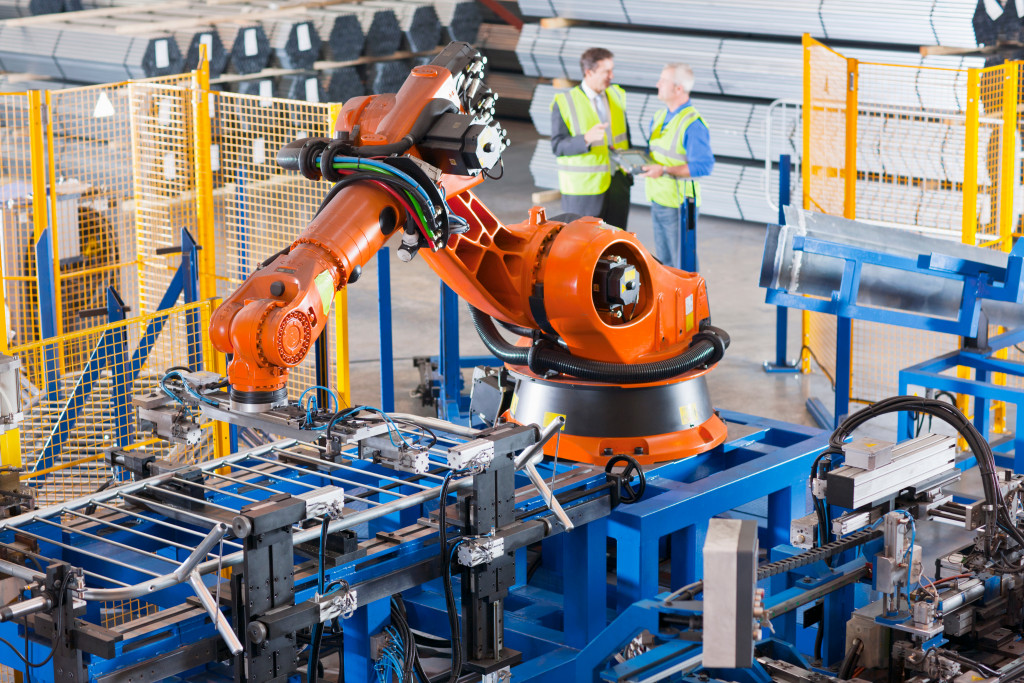- Robotics and automation allow businesses to increase productivity and efficiency.
- Automation software helps manage the process of using robots efficiently, resulting in higher profits.
- Robotics and automation are also being applied to other industries.
- Technology can ensure the safety of personnel on the production floor and reduce health risks.
- Data-driven manufacturing, predictive analytics, increased connectivity, and better collaboration allow businesses to stay competitive in today’s market.
As technology advances, so do the opportunities to use it in business. This is especially true in manufacturing, where technology can streamline processes and increase efficiency. This blog post will explore how technology has revolutionized manufacturing and how businesses can take advantage of these developments.

Robotics and Automation
Robots are becoming an increasingly common sight on factory floors around the world. They are taking over mundane or hazardous tasks and doing them faster and more accurately than human workers ever could.
Use of Automation Software
Automation software helps manage this process, ensuring that robots work as efficiently as possible. This increases productivity and causes fewer mistakes, resulting in higher profits for companies that utilize automation systems in their production processes.
Uses in Other Industries
Robotics and automation are also being applied to other areas of industry. From robotic arms on assembly lines to drones that monitor crops, these technologies are making it easier for businesses to perform tasks quickly, reliably, and with greater accuracy than ever before. They can even be used for delicate surgeries and medical diagnostics in healthcare settings. Automation is also finding its way into the home, with robotic vacuums and lawnmowers making life easier for homeowners.

Ensuring Safety on the Production Floor
Technology can ensure the safety of personnel on the production floor. Integrating technology into machinery and equipment can minimize or eliminate potential risks. Automated systems can detect hazardous conditions before they become a problem, alerting operators to take corrective action. Sensors and other monitoring devices around the facility can provide real-time data about working conditions and alert workers when trouble arises.
Tracking and Monitoring Systems
Additionally, tracking systems can monitor employee whereabouts, ensuring that they are in authorized areas and preventing collisions between personnel and machinery. By implementing these safety measures, companies can ensure a safe and healthy environment for their workers.
Reduce Health Risks
The use of technology on the production floor also helps to reduce health risks. Automated systems can detect air quality, noise, vibration, and temperature. This helps to maintain a comfortable environment for workers and reduce potential issues such as fatigue or heat stress.
Use of Safety Equipment
Safety equipment can also be used to protect workers from potentially hazardous materials. By equipping personnel with protective clothing and other equipment, companies can reduce the risk of injuries due to dangerous substances and ensure that their employees are safe while on the job.
Reduce Electrical Accidents
The use of reliable commercial electrical panels can reduce instances of accidents on the production floor. Companies can use the proper type of panel to ensure that the electrical system is up to code and meets all safety requirements. Additionally, these panels reduce the risk of short circuits or other hazards due to malfunctioning components. By implementing the latest safety technology, companies can ensure a safe and healthy work environment for their personnel.
Data-Driven Manufacturing
Manufacturing no longer takes place in a vacuum. Instead, it’s part of a larger data-driven ecosystem that includes research and development, supply chain management, customer feedback, and marketing efforts.
Identifying Trends
By collecting data from all of these areas and analyzing it with powerful analytical tools, businesses can identify trends and take action to improve their performance. For example, manufacturers can use data to better understand customer needs and develop new products or services faster than ever before.
Predictive Analytics
They can also use predictive analytics to anticipate demand for certain products or services. This allows businesses to be better prepared for customer orders, leading to increased efficiency overall.
Increased Connectivity
The internet of things (IoT) has made it easier for machines to communicate with each other. It allows manufacturers to monitor their equipment remotely while still having access to real-time data about its operations. This ensures that machines are running at optimal levels and provides insight into how they can be improved even further.
Monitor Inventory Levels
IoT devices also allow manufacturers to track inventory levels across multiple locations quickly and easily. This means stock won’t run out unexpectedly, or orders will be delayed due to a lack of parts. Keeping real-time track of the supply chain also helps manufacturers minimize waste and maximize efficiency.
Better Collaboration
Finally, IoT allows for increased collaboration between stakeholders, as they can communicate more easily and quickly than ever before. This makes it easier to collaborate on projects and share resources across different organizations or countries – making it possible for
Technology is revolutionizing the manufacturing industry by making it faster, more efficient, and more cost-effective. Businesses that embrace tech have the edge over those that don’t. There’s no shortage of ways technology is making manufacturing more efficient daily! Now is the time to take advantage of all the opportunities available to stay competitive in today’s market!

